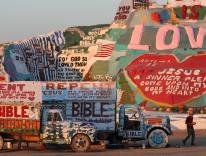On screen and in print, Paris is much in vogue these days. Midnight in Paris, Woody Allen’s ode to the City of Light in the 1920s, is an Oscar nominee for Best Picture, and David McCullough’s The Greater Journey: Americans in Paris spent months on bestseller lists. If we’re lucky, McCullough’s hefty history spanning the 1830s through the 1890s will become a television miniseries, narrated of course by the Pulitzer Prize–winning author himself.
When we think of American luminaries in Paris, most of us conjure those who worked and played so memorably there in the 1920s, often with nary a thought for those who went before. The hero of Woody Allen’s film is a contemporary writer giddily transported back to 1920s Paris, where he falls for a woman longing to live in the Paris of the belle époque, which McCullough touches on. But the greater part of The Greater Journey takes place in the decades before that, and McCullough’s stories, unlike Allen’s, are never romantic for long.
A vivid description of the Siege of Paris during the Franco-Prussian War—for example, during which thousands died of starvation and major culinary decisions boiled down to “Cat or rat?”—reminds us that even this city’s creative muse was periodically driven to desperation.
Those who made the “Greater Journey” include now-famous names such as author James Fenimore Cooper; painter George Catlin, who brought a troupe of his Plains Indian subjects with him; author/abolitionist Harriet Beecher Stowe; artist Mary Cassatt; and artist/inventor Samuel F. B. Morse. And they include the less famous, such as Paris-trained Elizabeth Blackwell, the first female doctor in America; William Wells Brown, a fugitive slave and writer; and Thomas Evans, a dentist much in demand by wealthy Parisians. Even then, America led the way in dental care.
You could say that art motivated them all, whether it was the art of politics, medicine, or social change—or simply the art of living. France’s crucial aid during America’s War of Independence from England set the stage. But the central drama was France’s own thirst for liberté, égalité, fraternité.
In Paris the Americans observed racial tolerance and integration still unheard of at home, uncommon opportunities for women, and fierce opposition to class distinctions. McCullough implies that they found Parisians in some ways more American than they yet were themselves.
The architectural beauty and underlying cultural depth of Paris, especially contrasted with a still young and unpolished America, was of course a—if not the—major attraction. It’s a point made most memorably in a chapter about the New York sculptor Augustus Saint-Gaudens. Stalled in his work and suffering from cancer, Saint-Gaudens had set out to kill himself by jumping into the Seine. But he was so overcome by the sight of the treasure-filled Louvre illuminated in bright sunlight that he aborted his plan. Paris was literally a lifesaver.
McCullough is an eminently evenhanded historian and writer, yet he does have obvious heroes, Saint-Gaudens among them. The author devotes more ink to him than to the equally industrious painter John Singer Sargent, another outsized talent who created outsized works. Perhaps that’s because Sargent’s oil paintings were essentially a one-man job, while the sculptor’s statues of Civil War heroes such as Admiral Farragut and General Sherman, both placed in New York, required a team of assistants and complex logistical maneuvers on both sides of the Atlantic.
Another McCullough hero is Elihu B. Washburne of Illinois, the American ambassador who alone among foreign diplomats refused to abandon his post throughout the horrific Siege of Paris (September 1870 to January 1871). Washburne saved many American lives, as well as those of hapless Germans caught on the wrong side. But, as McCullough writes, Washburne “longed only for peace and rest,” not accolades. “He hoped he had done his duty, he told a friend, but feared too much praise. ‘It is always perilous to be too popular.’”
Politics and fine arts are understandably this book’s mainstay. But a chapter titled “The Medicals” was to this reader the most fascinating. In the 1830s, America offered no medical training remotely comparable to that available in Paris, where hospitals treated all patients free of charge and foreign students paid no tuition. What’s more, the learning curve quickly rose for American “medicals” liberated from Puritan mores. In America, McCullough writes, “most women would have preferred to die than have a physician—a man—examine their bodies. It was a ‘delicacy’ nearly impossible to surmount, and as a consequence a great many American women did die, and young men in medical training in America seldom had any chance to study the female anatomy, other than in books.”
Dissection of corpses was also frowned upon at home, while in Paris it was an essential part of the surgical arts. “For all that was so morbidly unpleasant about work at the dissecting tables—the stench, the smoke—it was far better, every student came to appreciate, that they practice on the dead than on the living,” writes McCullough. No corner of any Paris hospital was closed to students, but that great advantage had a downside in operating rooms. Medical student Oliver Wendell Holmes described how acolytes of all nationalities crowded around star surgeon Guillaume Dupuytren, “a lesser kind of deity,” to watch him at work. To the French, McCullough writes, “everything was theater—un spectacle—even surgery.” But once the show was over, surgeons who played to the gallery typically forgot about their patients, whose second act often came on the dissecting table.
Reading The Greater Journey, which for maximum pleasure and absorption should be done at a leisurely pace, is like touring Paris with a terrific guide whose field of expertise is the nineteenth century. It’s far too much to take in during one visit, or one book, even at 456 pages (not counting notes). But in the end, you’ve gotten the high points, plus enough detail to make you crave a return visit.
